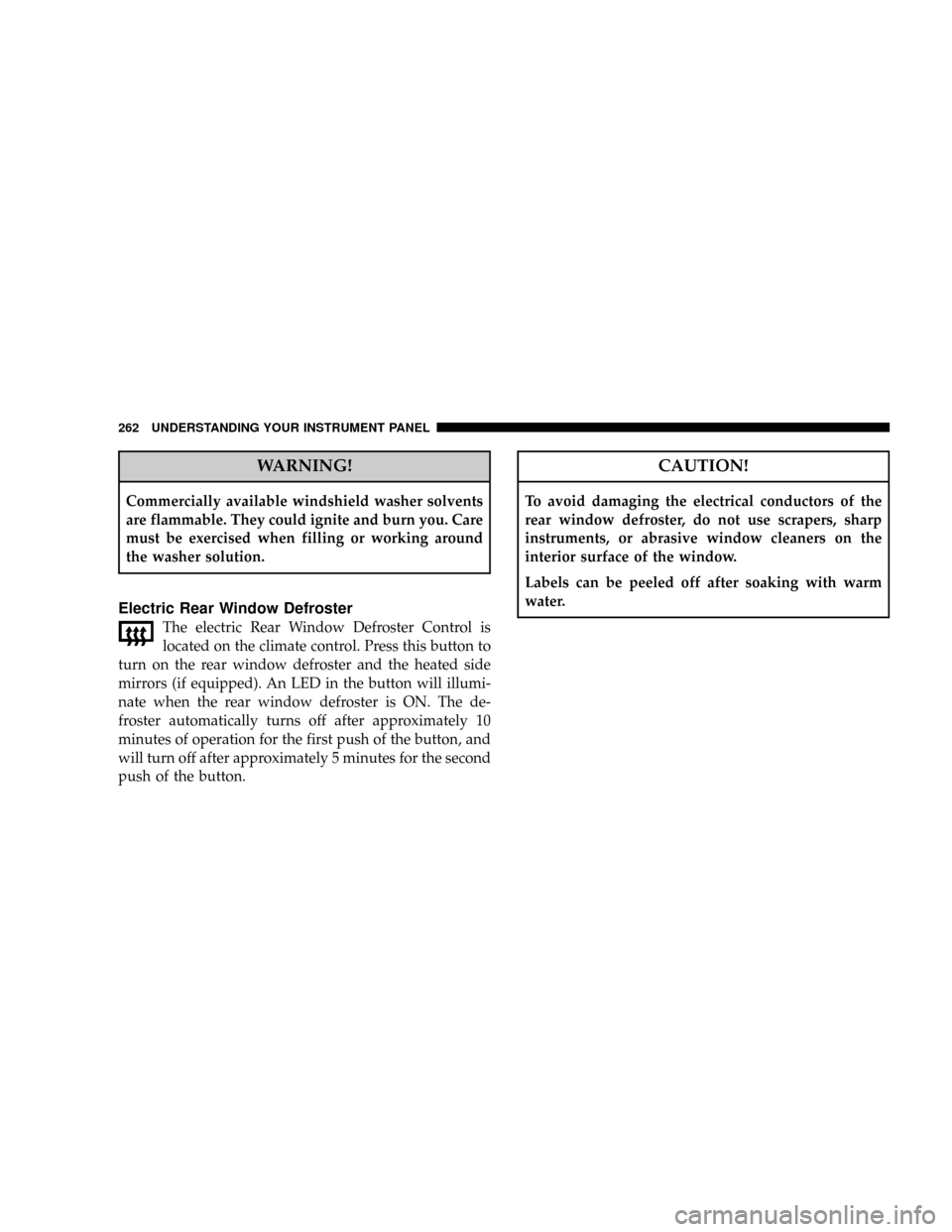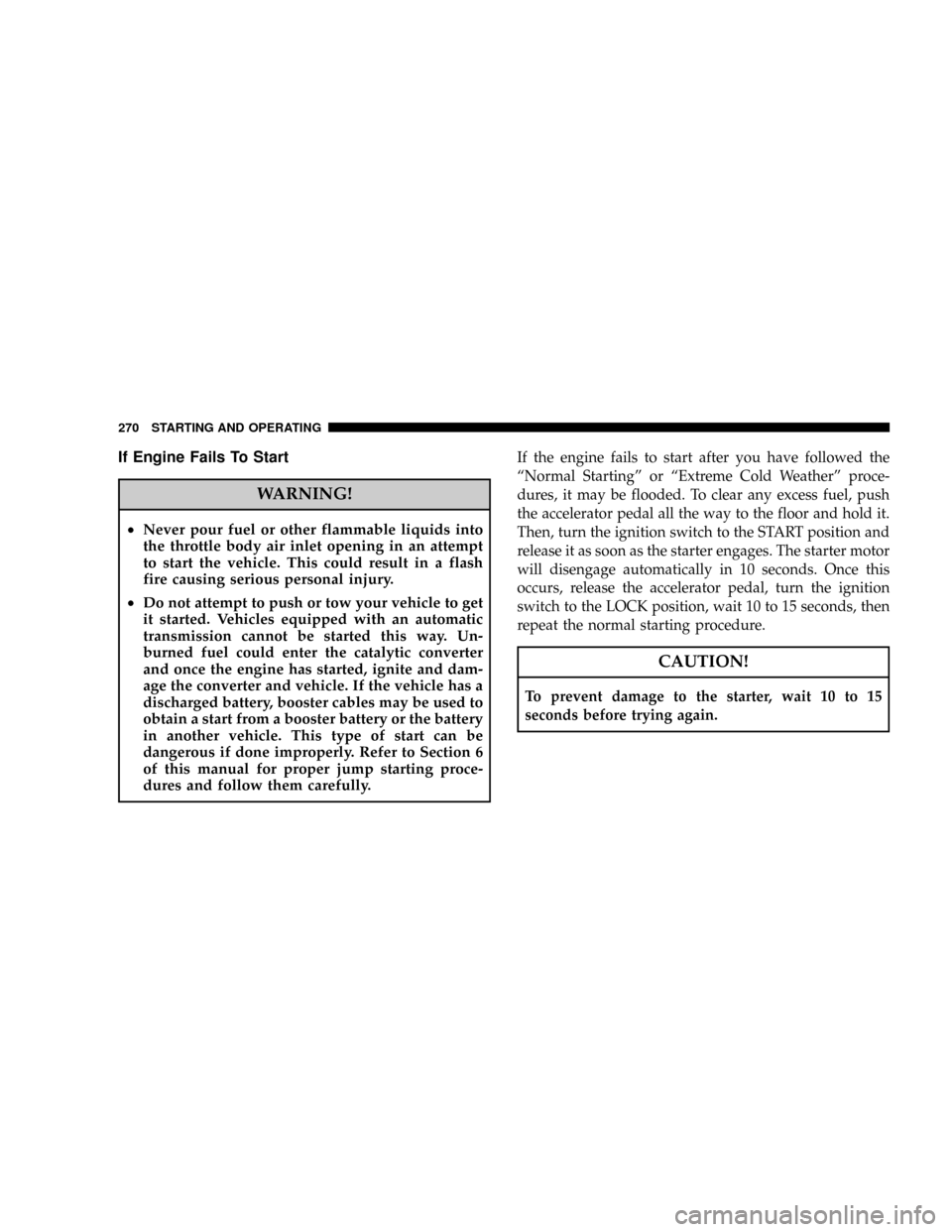DODGE MAGNUM 2008 1.G Owners Manual
Manufacturer: DODGE, Model Year: 2008, Model line: MAGNUM, Model: DODGE MAGNUM 2008 1.GPages: 482, PDF Size: 6.94 MB
Page 261 of 482

To use the rear washer, push the right side of the rear
wiper/washer switch in and hold while spray is desired
(maximum spray of 10 seconds). The rear wiper operates
for 2 wipe cycles after the switch is released.
Adding Washer Fluid
The windshield washer and rear window washer share
the same fluid reservoir. The reservoir is located in the
front of the engine compartment on the passenger side of
the vehicle. Be sure to check the fluid level at regular
intervals. Fill the reservoir with windshield washer sol-
vent (not radiator antifreeze) and operate the system for
a few seconds to flush out the residual water.
The fluid reservoir will hold nearly 1 gallon (4 liters) of
washer fluid when the message ªLow Washer Fluidº
appears in the Electronic Vehicle Information Center
(EVIC) Ð if equipped.
UNDERSTANDING YOUR INSTRUMENT PANEL 261
4
Page 262 of 482

WARNING!
Commercially available windshield washer solvents
are flammable. They could ignite and burn you. Care
must be exercised when filling or working around
the washer solution.
Electric Rear Window Defroster
The electric Rear Window Defroster Control is
located on the climate control. Press this button to
turn on the rear window defroster and the heated side
mirrors (if equipped). An LED in the button will illumi-
nate when the rear window defroster is ON. The de-
froster automatically turns off after approximately 10
minutes of operation for the first push of the button, and
will turn off after approximately 5 minutes for the second
push of the button.
CAUTION!
To avoid damaging the electrical conductors of the
rear window defroster, do not use scrapers, sharp
instruments, or abrasive window cleaners on the
interior surface of the window.
Labels can be peeled off after soaking with warm
water.
262 UNDERSTANDING YOUR INSTRUMENT PANEL
Page 263 of 482

STARTING AND OPERATING
CONTENTS
mStarting Procedures.....................267
NAutomatic Transmission................268
NNormal Starting (Tip Start)..............269
NExtremely Cold Weather (Below220ÉF Or
229ÉC).............................269
NIf Engine Fails To Start.................270
NAfter Starting........................271
mEngine Block Heater Ð If Equipped.........271
mAutomatic Transmission..................271NAutomatic Transmission Ð General
Information.........................272
NBrake/Transmission Shift Interlock System . . . 274
N4 Speed Automatic Transmission..........275
N5 Speed Automatic Transmission..........280
mAutoSticktÐ If Equipped................286
NAutoSticktOperation..................286
mAll Wheel Drive Ð If Equipped............287
mDriving On Slippery Surfaces..............287
5
Page 264 of 482

NAcceleration.........................287
NTraction............................288
mDriving Through Water..................288
NFlowing/Rising Water..................288
NShallow Standing Water.................289
mParking Brake.........................290
mBrake System..........................292
NAnti-Lock Brake System Ð If Equipped.....293
mPower Steering........................295
mMulti Displacement System (MDS) Ð 5.7L Engine
Only................................296
mTraction Control System (TCS) Ð If Equipped . . 296
mBrake Assist System (BAS) Ð If Equipped.....298mElectronic Stability Program (ESP) Ð
If Equipped...........................299
NSynchronizing ESP....................301
NESP/BAS Malfunction Indicator And ESP/TCS
Indicator Lights......................301
mTire Safety Information...................302
NTire Markings........................302
NTire Identification Number (TIN)..........306
NTire Loading And Tire Pressure...........307
mTires Ð General Information...............311
NTire Pressure.........................311
NTire Inflation Pressures.................312
NRadial-Ply Tires......................314
NCompact Spare Tire Ð If Equipped.........315
264 STARTING AND OPERATING
Page 265 of 482

NLimited Use Spare Ð If Equipped.........315
NTire Spinning........................316
NTread Wear Indicators..................317
NLife Of Tire.........................317
NReplacement Tires.....................318
NAlignment And Balance.................319
mSelf-Sealing Tires Ð If Equipped............320
mTire Chains...........................320
mSnow Tires...........................321
mTire Rotation Recommendations............321
mTire Pressure Monitor System (TPMS) Ð
If Equipped...........................322
NBase System Ð If Equipped..............325NPremium System Ð If Equipped..........327
NGeneral Information...................331
mFuel Requirements......................332
N2.7L Engine.........................332
N3.5L And 5.7L Engines..................332
NReformulated Gasoline.................333
NGasoline/Oxygenate Blends..............333
NMMT In Gasoline.....................334
NMaterials Added To Fuel................334
NFuel System Cautions..................334
NCarbon Monoxide Warnings..............335
mAdding Fuel..........................336
NFuel Filler Cap (Gas Cap)...............336
STARTING AND OPERATING 265
5
Page 266 of 482

NLoose Fuel Filler Cap Message............338
mVehicle Loading........................339
NVehicle Certification Label...............339
NGross Vehicle Weight Rating (GVWR).......339
NGross Axle Weight Rating (GAWR).........340
NOverloading.........................340
NLoading............................341
mTrailer Towing.........................342
NCommon Towing Definitions.............342NTrailer Hitch Classification...............346
NTrailer Towing Weights (Maximum Trailer
Weight Ratings)......................347
NTrailer And Tongue Weight..............349
NTowing Requirements..................350
NTowing Tips.........................355
mRecreational Towing (Behind Motorhome, Etc.) . . 357
NTowing This Vehicle Behind Another Vehicle
(Flat Towing With All Four Wheels On The
Ground)............................357
266 STARTING AND OPERATING
Page 267 of 482

STARTING PROCEDURES
Before starting your vehicle, adjust your seat, adjust the
inside and outside mirrors, fasten your seat belt, and if
present, instruct all other occupants to buckle their seat
belts.WARNING!
²Never leave children alone in a vehicle. Leaving
children in a vehicle unattended is dangerous for a
number of reasons. A child or others could be seri-
ously or fatally injured. Don't leave the keys in the
ignition. A child could operate power windows,
other controls, or move the vehicle.
²Do not leave animals or children inside parked
vehicles in hot weather; interior heat build up may
cause serious injury or death.
²Be sure to turn off the engine and remove the key
from the ignition switch if you want to rest or sleep
in your car. Accidents can be caused by inadvertently
moving the gear selection lever. Accidents can also
be caused by pressing the accelerator pedal. This
may cause excessive heat in the exhaust system,
resulting in overheating and vehicle fire, which may
cause serious or fatal injuries.
STARTING AND OPERATING 267
5
Page 268 of 482

Automatic Transmission
The gear selector must be in the ªNº (Neutral) or ªPº
(Park) position before you can start the engine. Apply the
brakes before shifting into any driving gear.CAUTION!
Damage to the transmission may occur if the follow-
ing precautions are not observed:
²Shift into PARK only after the vehicle has come to
a complete stop.
²Shift into or out of REVERSE only after the
vehicle has come to a complete stop and the engine
is at idle speed.
²Do not shift from REVERSE, PARK, or NEUTRAL
into any forward gear when the engine is above
idle speed.
²Before shifting into any gear, make sure your foot
is firmly on the brake pedal.
268 STARTING AND OPERATING
Page 269 of 482

Normal Starting (Tip Start)
NOTE:Normal Starting of either a cold or a warm
engine is obtained without pumping or depressing the
accelerator pedal.
Do notpress the accelerator. Use the Fob with Integrated
Key to briefly turn the ignition switch to the START
position and release it as soon as the starter engages. The
starter motor will continue to run, and it will disengage
automatically when the engine is running. If the engine
fails to start, the starter will disengage automatically in 10
seconds. If this occurs, turn the ignition switch to the
LOCK position, wait 10 to 15 seconds, then repeat the
normal starting procedure.
Extremely Cold Weather (below220ÉF or229ÉC)
To insure reliable starting at these temperatures, use of an
externally powered electric engine block heater (available
from your dealer) is recommended.
STARTING AND OPERATING 269
5
Page 270 of 482

If Engine Fails To Start
WARNING!
²Never pour fuel or other flammable liquids into
the throttle body air inlet opening in an attempt
to start the vehicle. This could result in a flash
fire causing serious personal injury.
²Do not attempt to push or tow your vehicle to get
it started. Vehicles equipped with an automatic
transmission cannot be started this way. Un-
burned fuel could enter the catalytic converter
and once the engine has started, ignite and dam-
age the converter and vehicle. If the vehicle has a
discharged battery, booster cables may be used to
obtain a start from a booster battery or the battery
in another vehicle. This type of start can be
dangerous if done improperly. Refer to Section 6
of this manual for proper jump starting proce-
dures and follow them carefully.
If the engine fails to start after you have followed the
ªNormal Startingº or ªExtreme Cold Weatherº proce-
dures, it may be flooded. To clear any excess fuel, push
the accelerator pedal all the way to the floor and hold it.
Then, turn the ignition switch to the START position and
release it as soon as the starter engages. The starter motor
will disengage automatically in 10 seconds. Once this
occurs, release the accelerator pedal, turn the ignition
switch to the LOCK position, wait 10 to 15 seconds, then
repeat the normal starting procedure.
CAUTION!
To prevent damage to the starter, wait 10 to 15
seconds before trying again.
270 STARTING AND OPERATING